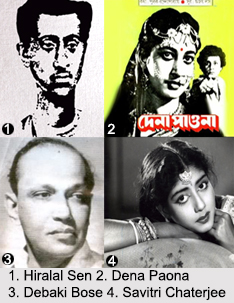Post-Production stage in film making is extremely crucial as it is here that the film is assembled by the Film Editor. The modern use of video in the film-making process has resulted in two workflow variants: one using entirely film, the other using a mixture of film and video:
Film Workflow: The original camera film (negative) is developed and copied to a one-light. A one-light work-print is a cinematographic term used to describe a timed work-print made using a single setting of the three lights (red, green and blue) used to make a colour film print. Since a fully timed print requires the presence of a skilled person called a colour timer (US) or film grader (UK), a one-light print is more economical for printing dailies (positive) from rushes (negative).Cinematographers often require one-light Work-prints to better judge their film exposures. Work print (positive) for editing with a mechanical editing machine. An edge code is recorded onto film to locate the position of picture frames. An edge code or edge number is a number printed on film for identification or information purposes. There are three types of edge numbering:
Latent image edge numbering - applied by the film manufacturer and visible only on processed film
Visible ink image edge numbering - applied by the film manufacturer and visible on raw stock and processed film
Laboratory image edge numbering - applied by the laboratory after film processing.
Edge codes are also known as edge number, code number, footage number, negative number, ink number, key number, key edge number or Key Kode.
Video Workflow: The original camera negative is developed and telecined to video for editing with computer editing software. A time-code is recorded onto video tape to locate the position of picture frames. The first job of the film editor is to build a rough cut taken from sequences (or scenes) based on individual "takes" (shots). The purpose of the rough cut is to select and order the best shots. The next step is to create a fine cut by getting all the shots to flow smoothly in a seamless story. Finding the perfect transition point between shots is called "trimming". After the fine cut has been screened and approved by the director and producer the picture is "locked", meaning no further changes are made.
Next, the editor creates a negative cut list (using Edge Code) or an edit decision list (using Time code) either manually or automatically. These edit lists identify the source and the picture frame of each shot in the fine cut. Once the picture is locked, the film passes out of the hands of the editor to the sound department to build-up the sound track. The voice recordings are synchronized and the final sound mix is created. The sound mix combines sound effects, background sounds, foleys, ADR, dialogue, and music. The sound track and picture are combined together, resulting in a low quality Answer Print (positive) of the movie. There are now two possible workflows to create the high quality Release Print (positive) depending on the recording medium:
Film Workflow: The cut list that describes the film-based Answer Print is used to cut the Original Colour Negative (OCN) and create a colour timed copy called the Colour Master Positive (positive) or Inter-positive (positive) print. For all subsequent steps this effectively becomes the master copy. The next step is to create a one-light copy called the Colour Duplicate Negative (negative) or Inter-negative (negative) print. It is from this that many copies of the final theatrical Release Print (positive) are made. Copying from the Inter-negative is much simpler than copying from the Inter-positive directly because it is a one-light process; it also reduces wear-and-tear on the Inter-positive print.
Video Workflow: The edit decision list that describes the video-based Answer Print is used to edit the Original Colour Tape (OCT) and create a high quality Colour Master Tape. For all subsequent steps this effectively becomes the master copy. The next step uses a Film Recorder to read the Colour Master Tape and copy each video frame directly to film to create the final theatrical Release Print (positive). Finally the film is previewed, normally by the target audience, and any feedback may result in further shooting or edits to the film.




















